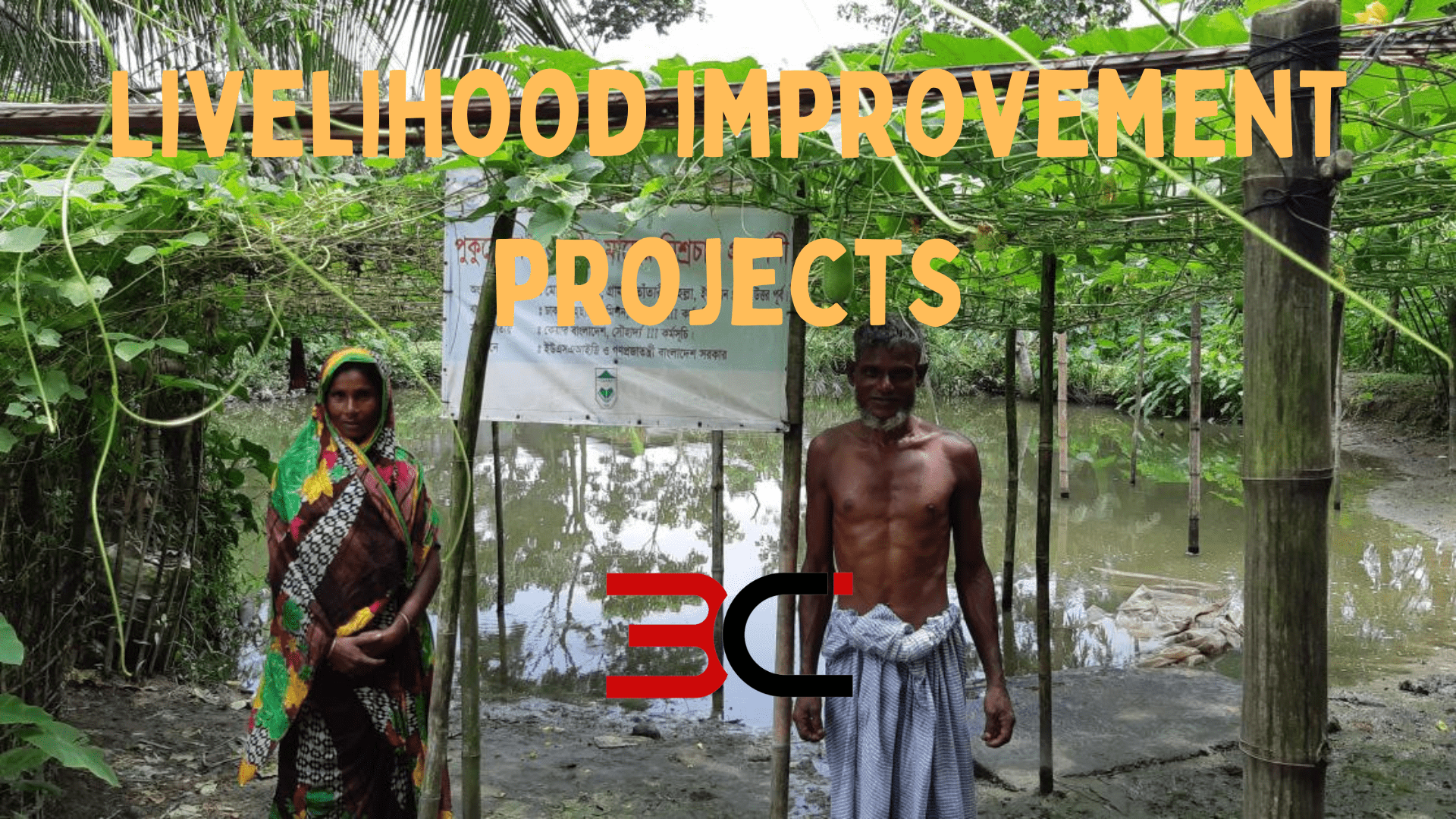Livelihood improvement projects in Bangladesh are designed to reduce poverty and improve the lives of the people of Bangladesh.
By increasing access to health, education, and markets, these projects may have a long-lasting impact on the lives of those living in poverty in Bangladesh. Livelihood improvement projects also have access to natural resources, technology, markets, and local capacity. At the same time, these also focus on improving the road infrastructure.
This blog will explain why livelihood improvement projects can make a real difference in the lives of the people of Bangladesh.
What is a Livelihood Improvement Project?
A livelihood improvement project is a comprehensive strategy to improve the quality of life in communities by increasing access to resources and services. Although these projects have various purposes, they are mainly designed for three common ones. These include –
- Reducing poverty in the country.
- Creating economic opportunities.
- Fostering resilience within a certain range.
Typically, livelihood improvement projects involve activities such as road construction, building local capacity, access to technology, and access to natural resources. Additionally, they may require access to health centers, schools, and markets.
Livelihood improvement projects are essential for developing countries like Bangladesh, where poverty and lack of access to essential services are major issues. With the help of these projects, communities can gain more control over their lives and become better equipped to deal with potential shocks.
Why Livelihood Improvement Projects are Important in Bangladesh?
Livelihood improvement projects are important in Bangladesh because they can improve the quality of life for many people. These projects are important since they have a positive impact on both the environment and the people in Bangladesh.
Let’s take a look at some of the major importance of livelihood improvement projects in Bangladesh –
- Road Infrastructure
The projects typically involve the construction of new roads and the repair and improvement of existing roads. This can include building bridges and culverts, paving roads, and improving drainage systems.
Improved roads provide better access to electricity, internet connections, and other sources of communication. These can help farmers and others living in rural areas gain access to markets and better resources. Improved road infrastructure not only makes it easier for people to get around, but it also makes it easier to access technology and natural resources.
Furthermore, improved roads enable more efficient transportation of goods. Hence, this can help reduce costs associated with transportation and boost local economies. Finally, people can easily access health centers and schools through improved roads.
- Local Capacity Building
Local capacity-building initiatives are essential for Bangladesh’s economic growth. This can reduce poverty and contribute to long-term development.
Local capacity building can implement innovative projects that are relevant to local needs. These projects can help local communities develop their strategies and techniques to manage their resources sustainably. For example, they may learn how to use agroforestry, conservation agriculture, or permaculture techniques to improve their production yields.
Moreover, these projects may help communities find ways to earn extra income through activities such as beekeeping or livestock rearing.
- Access to Natural Resources
In Bangladesh, access to natural resources is essential for any type of livelihood improvement project. Access to these resources can make people self-sufficient and provide them with the materials they need to sustain their lives. Access to natural resources such as land, water, and air is crucial to improving the livelihoods of people in the country.
Technically speaking, livelihood improvement projects can reduce environmental degradation. For example, projects may include the reforestation of degraded forests, soil conservation practices, and the protection of wetlands. Such initiatives protect biodiversity and reduce pollution.
With the implementation of livelihood improvement projects, rural people can access land and water sources that are necessary for farming and other agricultural activities. On top of that, better air access and soil quality will aid in raising crop yields.
- Technology
Investing in technology is essential for improving livelihoods in Bangladesh. It can reduce poverty by creating new economic opportunities. This can also improve vital services like healthcare and education.
For instance, introducing digital payments and e-commerce platforms will help small businesses expand the local market. This will also provide a platform for people to engage in online trade. As a result, this can reduce transaction costs and eliminate the need for physical cash.
Technology can also be used to improve the quality of education in rural areas. This can facilitate remote learning through various digital learning programs. Aside from that, technology is the key to building virtual libraries and giving users access to educational materials from all over the world.
- Access to Health Centers
Projects aimed at boosting livelihoods can give more people access to specialized medical care, which is often lacking in rural areas. For example, these projects could provide access to mental health services, cancer treatment, HIV/AIDS care, and other specialized services that are not available elsewhere.
By improving access to health centers, these projects can improve the overall health of people in Bangladesh. Since rural people will have better access to health centers, this can reduce the burden on hospitals. Therefore, the waiting times for medical care in hospitals will be reduced.
- Access to Schools
One of the key benefits of a livelihood improvement project in Bangladesh is access to schools. In many rural areas of the country, people lack access to basic educational facilities. These projects provide an opportunity to build schools in the local area, giving students the chance to gain valuable qualifications.
Improved roads and infrastructure allow children to travel to distant towns to attend more advanced educational institutions. This provides them with a greater range of choices when it comes to selecting a higher education provider. Improved road infrastructure also makes it easier for teachers to reach rural schools, ensuring students receive a better education.
Several Livelihood Improvement Projects in Bangladesh
In Bangladesh, there are several livelihood improvement projects underway. Some of the projects that are ongoing and mentionable are –
1) Nuton Jibon Livelihood Improvement Project
This project was launched in 2018 with a commitment to improving the livelihoods of more than 4 million people in the country. It is focused on several improvements, such as –
- Promoting climate-resilient agricultural practices.
- Improving irrigation and drainage systems.
- Providing technical support for small-scale agribusinesses.
- Increase incomes and reduce poverty among the rural population.
2) Bangladesh Rural Advancement Committee (BRAC)
BRAC is a non-governmental organization with a focus on rural development. Their goal is to increase access to safe water, sanitation, nutrition, and education for the rural poor. They also work to strengthen local capacity and improve access to financial services and markets.
3) Haor Infrastructure and Livelihood Improvement Project
This project was designed to improve the water resources in haor (wetland) areas in Bangladesh. It seeks to increase access to safe drinking water and sanitation services, improve drainage and irrigation systems, and promote sustainable agriculture. The project will also create jobs in rural areas by providing technical assistance and financial support for small-scale entrepreneurs.
4) “Leaving no one behind” by UNDP
This project seeks to improve the livelihoods of the most vulnerable populations in Bangladesh. It focuses on providing access to essential services, such as healthcare and education. This will also promote financial literacy and job-creation programs. By promoting green energy initiatives and improving natural resource management systems, it also aims to increase climate change resilience.
5) Bangladesh Poverty Reduction Fund (BPRF)
This is another major project that aims to reduce poverty in Bangladesh. This project makes essential services such as health care and education easy to reach. In addition, it continuously fosters economic growth in underdeveloped areas while producing jobs. The BPRF is funded by the World Bank and implemented by the government of Bangladesh.
6) Strengthening Community Driven Development (SCDD)
This is a major initiative for reducing poverty in rural areas. The project is implemented by the United Nations Development Programme (UNDP). The SCDD will promote local economic development, improve access to basic services, provide necessary training, and give technical assistance to empower rural communities.
7) Bangladesh Investment Climate Improvement Project (BICIP)
This is designed to improve the business environment in Bangladesh. The project focuses on streamlining regulations, supporting SMEs (Small and Medium Enterprises), and improving access to finance and capital markets.
The After-Effects of a Livelihood Improvement Project
The effects of a successful livelihood improvement project are far-reaching. Individuals and communities are able to benefit from improved access to natural resources, technology, and markets. Also, there is an improved quality of life that comes with such projects.
Better roads and other infrastructure mean improved transportation. This means better and quicker access to health centers and schools. In turn, this can lead to better educational and healthcare opportunities for communities. Also, communities are able to gain access to new markets. Otherwise, poor infrastructure won’t make all these possible.
Furthermore, livelihood improvement projects build local capacity. Communities are trained in various skills that allow them to utilize their resources. These skills not only improve livelihoods but also provide long-term economic stability for the community.
Overall, the after-effects of a successful livelihood improvement project are wide-reaching. They have the potential to improve the lives of those in the local community drastically. People and communities are able to generate more income and live better lives thanks to improved infrastructure and increased local capacity.
Closing Notes
Livelihood improvement projects in Bangladesh are essential to the economic and social development of the country. These projects provide access to natural resources, technology, health centers, and schools. This gives individuals greater opportunities to improve their own lives and those of their communities.
As such, it is important for countries like Bangladesh to invest in livelihood improvement projects to ensure a better future for their citizens.

